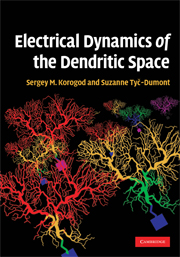Book contents
- Frontmatter
- Contents
- Preface
- 1 Definition of the neuron
- 2 3D geometry of dendritic arborizations
- 3 Basics in bioelectricity
- 4 Cable theory and dendrites
- 5 Voltage transfer over dendrites
- 6 Current transfer over dendrites
- 7 Electrical structure of an artificial dendritic path
- 8 Electrical structure of a bifurcation
- 9 Geography of the dendritic space
- 10 Electrical structures of biological dendrites
- 11 Electrical structure of the whole arborization
- 12 Electrical structures in 3D dendritic space
- 13 Dendritic space as a coder of the temporal output patterns
- 14 Concluding remarks
- Index
- References
1 - Definition of the neuron
Published online by Cambridge University Press: 03 May 2010
- Frontmatter
- Contents
- Preface
- 1 Definition of the neuron
- 2 3D geometry of dendritic arborizations
- 3 Basics in bioelectricity
- 4 Cable theory and dendrites
- 5 Voltage transfer over dendrites
- 6 Current transfer over dendrites
- 7 Electrical structure of an artificial dendritic path
- 8 Electrical structure of a bifurcation
- 9 Geography of the dendritic space
- 10 Electrical structures of biological dendrites
- 11 Electrical structure of the whole arborization
- 12 Electrical structures in 3D dendritic space
- 13 Dendritic space as a coder of the temporal output patterns
- 14 Concluding remarks
- Index
- References
Summary
The biologist
The shapes of the dendritic arborization of vertebrate neurons is a unique property which differentiates the nervous tissue from all the other tissues of the organism. The neuron doctrine, which we owe to Santiago Ramón y Cajal (Ramón y Cajal, 1904, 1911),was established 50 years after the cellular theory proposed by Schwann in 1839. This long period of trial and error and of vigourous opposition by the adherents of the reticularism is simply explained by the great difficulty of recognizing a nerve cell on histological preparations (Figure 1.1).
It was only after the discovery of the Golgi method, which is a selective technique for visualizing nerve cells and their prolongations that Ramón y Cajal established the first fundamental concept of neuroscience:
All becomes clear in our minds. Why do dendritic arborizations exist, why are they so varied, so abundant, so extensive? We understand now. Simply to enable the cell to receive, and to transmit to its cylinder-axis, the greatest possible variety of signals, from as many different sources as possible; put simply, to make of the cell a microcosm whose connections to the interior and exterior worlds are as numerous and complex as possible.
He called the nervous tissue the most intricate structure known in the living world. He observed a great number of neurons stained with the Golgi method in a variety of species. The comparison of dendritic morphologies of neurons located in homologous regions of the brains of different animals led him to formulate what we call the ‘shape hypothesis’. It was in the darwinism context of the time and tuned with the comparative phylogenetic approach.
- Type
- Chapter
- Information
- Electrical Dynamics of the Dendritic Space , pp. 1 - 12Publisher: Cambridge University PressPrint publication year: 2009



